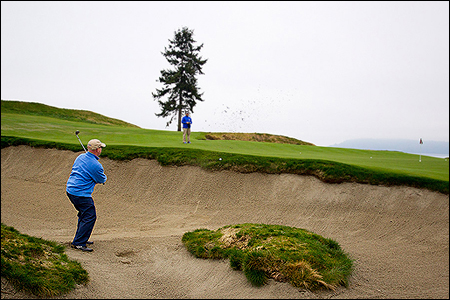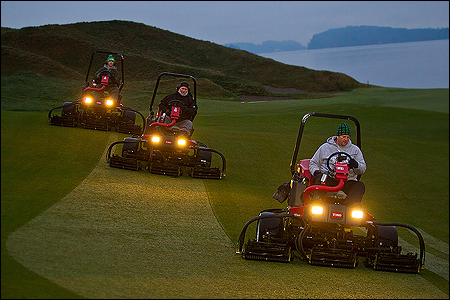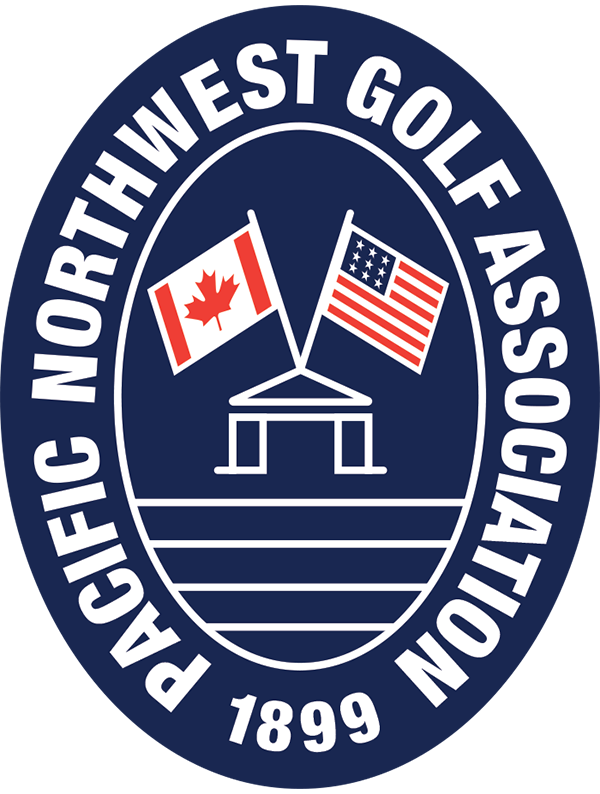U.S. Open Preparation a Winter Focus at Chambers Bay
By Scott Lipsky, USGA
February 10, 2015
History will be made when the 115th U.S. Open is contested in June at Chambers Bay, in University Place, Wash. The first U.S. Open staged in the Pacific Northwest will also be just the fourth played at a municipally owned golf course, following in the footsteps of the Black Course at Bethpage State Park (2002, 2009) and the South Course at Torrey Pines (2008).

The excitement in the surrounding area is palpable. All available volunteer positions were filled within two days and Gallery tickets are sold out for all four days of competition. More eyes will be on the Robert Trent Jones II layout than ever before, and Pierce County, which owns the course, and Kemper Sports, which manages it, have implemented an aggressive maintenance strategy during the fall and winter months to ensure that Chambers Bay is ready when the world’s best arrive this summer.
The weather is mild enough to allow Chambers Bay to stay open year-round, but some adjustments have been made in advance of the U.S. Open. In an effort to reduce overall traffic, tee time intervals have been increased to 14 minutes from the customary 10 or 11, and the course is closed for play on certain days during the fall and winter. Six greens have also been closed during the fall and winter.
“For Chambers Bay to do this is just a great thing,” said Darin Bevard, the USGA’s director of championship agronomy. “Limiting play, limiting traffic to make sure that these greens are in the best shape possible so they can showcase Chambers Bay is important, so when the USGA arrives to do setup, we’re not compromised for the U.S. Open.”
Golfers who have played at Chambers Bay recently have likely seen covers on the closed greens, leading some to be concerned about their condition with the national championship just four months away. Not to worry, says Matt Allen, Chambers Bay general manager.
“The perception is that a temporary green or a covered green is evidence of either disease or a major issue of some kind, versus being a proactive and preventive measure associated with the dramatic reductions in play,” said Allen, who has been at Chambers Bay since 2008. “The green covers allow us to incubate the turf, hold the moisture, keep temperatures up and keep us growing grass through the winter, when we might otherwise go completely dormant.”
Chambers Bay consists primarily of fine fescue grass, another U.S. Open first, and another reason why additional measures are being instituted to protect the greens outside of the growing season. A staple of many British Open sites, fescue requires less water than most grass types, which is advantageous from a sustainability standpoint, but it has thin density and is less wear-tolerant.
“When you have a small fescue putting surface and you put traffic on it at a time when it’s not growing, there can be wear issues,” said Larry Gilhuly, agronomist for the USGA Green Section West Region, who has made regular visits to Chambers Bay in preparation for the championship. “No. 15 is the only hole that we’re still watching closely. That said, it is already better than it was coming out of last winter.”
Whereas the other five affected holes have alternate greens in place, the logistics of No. 15, a short par 3, do not allow for that option. Instead, golfers play to the covered green, which has a flagstick but does not have a hole cut. Once a player has hit their ball on the green, they add one or two strokes to their score, depending on how close they are to the flagstick. In an effort to minimize foot traffic, a Chambers Bay staff member is stationed on No. 15 throughout the day to retrieve the balls. It’s a unique solution to a unique challenge.
“It was pretty obvious that we don’t have an alternate location, so it was either that or skip the hole,” said Allen, who prior to his arrival at Chambers Bay spent nine years at Bandon Dunes Golf Resort in Bandon, Ore., which will host the inaugural U.S. Women’s Amateur Four-Ball Championship in May and is also a fescue facility. “It’s just an example of how we’ve had to get creative.”
Allen and his staff wanted to ensure that the impact of the green closures on the golfers’ experiences was minimal. Of the five alternate greens, four are prepared as regular putting surfaces and, where feasible, have been placed next to bunkers to provide challenging approach shots. No. 12, typically a drivable par 4 which currently plays as a par 3, is the exception.
“We’ve had folks on [holes] 7, 10 and 13 tell us if we hadn’t told them before they played, they wouldn’t have known they were playing a temporary green,” said Allen. “They remain architecturally interesting – golfers putt to a regular hole, same turf, green speeds comparable to the putting greens.”

The winter care of the greens has been the primary focus of the USGA and the Chambers Bay staff, with covers going on all 18 greens plus the facility’s two practice greens when the course is closed and the weather dictates. The staff hasn’t measured green speed since September, and when it comes to preparing for the U.S. Open, green speed will not come into play until much closer to the championship.
“I start to look early in U.S. Open advance week to start prepping the greens from a speed perspective, because there’s no reason to put stress on the greens,” said Bevard. “The goal is to get them up to speed for the first day of practice rounds. We don’t want to put stress on the grass before we need to, so a slow ramp-up during the advance week is what I look for.”
While there is plenty of work to be done between February and June, Gilhuly is excited by what he has seen, and he has an important frame of reference in gauging the course’s condition, as Chambers Bay also hosted the 2010 U.S. Amateur.
“These greens have better density in the middle of the winter than I’ve ever seen,” said Gilhuly. “They are doing some things here that I just don’t see at municipal golf courses. The course is built on sand; their fertilizer levels are low, their water levels are low, they topdress the fairways on a regular basis, which is part of creating firm and fast playing conditions. These fairways are excellent, the ball releases, even if we get rain. Kudos to the county, kudos to Kemper Sports.”
The winter efforts of Allen, superintendent Josh Lewis, director of agronomy Eric Johnson, and their team are paying off, and have Chambers Bay in position for a smooth transition to spring preparations for the U.S. Open. Allen sees the benefits extending far beyond impressing the world’s best golfers and the millions of fans who will tune in around the world.
“We really think this period between now and the championship is also going to prepare us for the best public golf we’ve ever had,” he said.
Scott Lipsky is the manager of websites and digital platforms for the USGA. Email him at [email protected].





